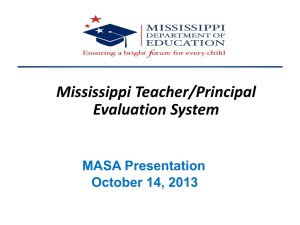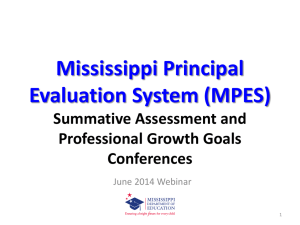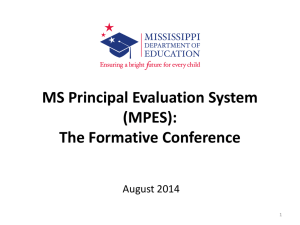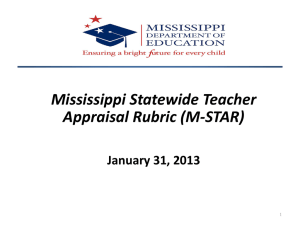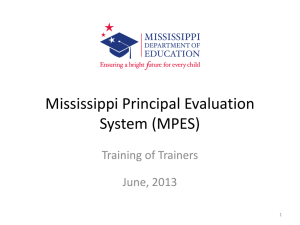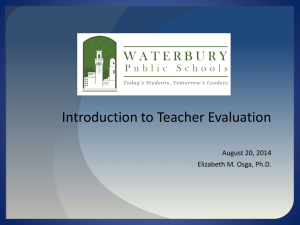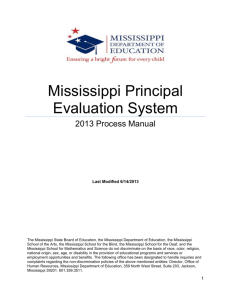and Teacher Evaluation - Mississippi Department of Education
advertisement
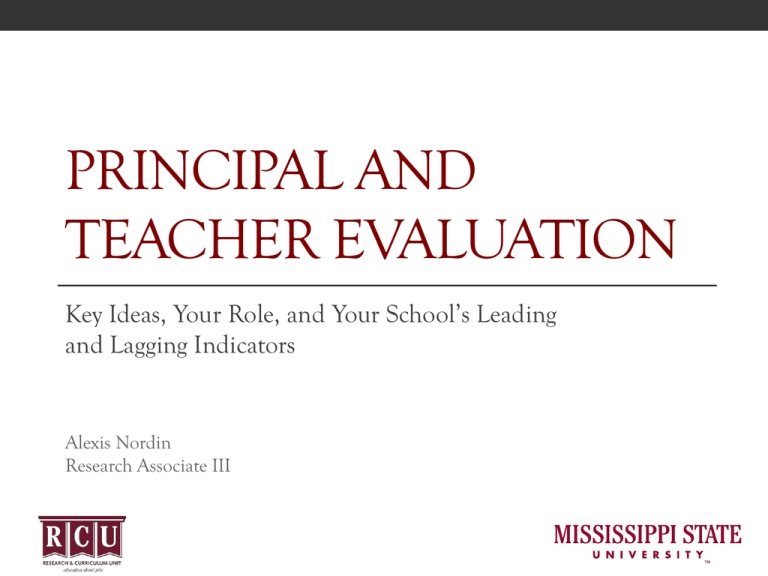
PRINCIPAL AND TEACHER EVALUATION Key Ideas, Your Role, and Your School’s Leading and Lagging Indicators Alexis Nordin Research Associate III Goals for Today • Overview of the Principal Evaluation Components & Timeline • Introduction to the MPES Goal-Setting & Scoring Process • Brief Summary of Teacher Evaluation & SLOs • The Principal-Teacher Connection • Definition of Leading and Lagging Indicators • Counselors’ Role in the New Evaluation Processes MPES OVERVIEW & TIMELINE MPES Overview The Mississippi Principal Evaluation System (MPES) is mandatory for all districts this year. • Principal evaluation, including a student growth component, is a requirement of Mississippi’s ESEA flexibility waiver. • Last year 34 districts (219 principals) piloted a principal evaluation, focusing primarily on the VAL-ED component. • Who is required to participate this year? • Head principals of K-12 public schools • Career and technical education directors • Assistant principals & alternative school principals are NOT required to participate this year (local decision) 5 MPES Components Organizational Goals (2) 20% Circle Survey 30% Mathematics Goal 25% Language Arts Goal 25% 6 MPES Process and Target Dates Student/School Growth Scored AUG: Goal-Setting Conference DEC.-JAN: Formative Conference APR.: Circle Survey Conference JULY: Summative Assessment Conference Professional Growth Goals Conference 7 Goal-Setting Conference Formative Conference Circle Survey Conference Language Arts Goal: Form 2A Discuss Progress Toward Goals Mathematics Goal: Form 2B Certified Staff Complete Survey (Mid-Year) Adjust Strategies and Add Support Organizational Goals: Form 2C Complete Form 3 Input Data in Canvas Input Data in Canvas Principal and Supervisor Complete Survey (Mid-Year) Principal and Supervisor Review Circle Survey Results Input Data in Canvas Summative Assessment & PGG Conferences Discuss Goals and Rate Achievement of Goals Complete Form 4 Discuss Professional Growth Goals Complete Professional Growth Goals Form Input Data in Canvas MPES GOAL-SETTING & SCORING 9 Setting MPES Language Arts and Mathematics Goals (50%) • Schoolwide goals - Based on statewide tests (i.e., MCT2). • Principals and supervisors - Set quantifiable goals and quantifiable ways to measure progress toward each goal at the start of the school year (Sept. 6). 10 Setting MPES Organizational Goals (20%) • Organizational Goals (2) Currently Based On: Leading indicators Lagging indicators These can include student assessments, but the Language Arts and Mathematics goals should not be used again in the Organizational Goals. 11 Goal Quantification All Goals Must Be: • Measurable (numerical targets) • Ranges/degrees of achievement • Mutually exclusive/contiguous • Realistic/based on data • Attainable/achievable • Consistent and fair • Agreed upon by the principal and supervisor at the beginning of the year 12 MPES Goal Scoring A Principal’s Goal Score is Based on a 1-4 Range: 4 – Distinguished (Substantially exceeds goal) 3 – Effective (Approaches or attains goal) 2 – Emerging (Some but not sufficient progress toward goal) 1 – Unsatisfactory (Little or no progress toward goal) 13 MPES Summative Assessment Rating Final Scoring (for Principals) TEACHER EVALUATION OVERVIEW & SLOS 15 Teacher Evaluation The process is being gradually implemented over the next 3 years. • You will see full implementation in the 2015-2016 school year. • MS Teacher Evaluation Components PGG 20% M-STAR 30% Student Growth 50% MS Teacher Evaluation 2015-2016 20% 20% 30% 30% 20% 20% 30% 30% STATE TESTED TEACHERS • M-STAR (30%) • PGG (20%) • Schoolwide Growth (20%) • Individual Growth (30%) NON-STATE TESTED TEACHERS • M-STAR (30%) • PGG (20%) • Schoolwide Growth (20%) • SLOs (30%) M-STAR Overview Five domains (weighted equally) • Planning • Assessment • Instruction • Learning Environment • Professional Responsibilities 20 standards included within the domains M-STAR Observation Process FALL: Formative Observation: including pre/post conference FALLSPRING: 5 WalkThroughs feedback SPRING: Summative Observations: including pre/post conference PGG/M-STAR Annual Cycle Begin School Year with 2 PGG Summative Conference PGG Developed Summative Observation Teacher works on approved PD activities Teacher works on approved PD activities Formative Observation FEEDBACK Walk Through Observations FEEDBACK Student Learning Objectives (SLOs) • Can more accurately be described as “student growth targets” • Applicable to teachers of non-tested grades/subjects • CTE population is piloting SLOs this year • Pre-Post Test • Pre-assessment scores set a baseline • Post-assessment determines growth • Individual student growth targets will be calculated for each student based on a baseline • Statewide goal is that students will show at least 60% of their potential growth on the end-of-course assessment. • Statewide goal is that at least 70% of a teacher’s students will meet growth. SLO Calculation Target 60% Student Growth Pre-Test Early Fall Scores 20 Post-Test Spring Potential 100 Could Improve 80 points Growth 60% 60% x 80 = 48 20 + 48 = 68 This Student’s Post-Test Target Teacher’s Report Student Pre-Test Growth Target Post-Test Met Growth Mike Julie Pam Sean Brad Amanda Bill Kristen Marilyn Jean 20 15 10 10 30 40 10 12 22 32 68.0 66.0 64.0 64.0 72.0 76.0 64.0 64.8 68.8 72.8 70 64 75 80 70 80 69 69 69 69 YES NO YES YES NO YES YES YES YES NO Number Met Number Not Met % Student Meeting Target 7 3 70% Quantification Quantification is required to convert the GOAL to a score that aligns with the teacher rating system. Example: 70% of Teacher’s Students Met Growth Evaluation Rating SGT Met (%) 4 >= 90% 3 70%-89% 70% = 3 Scoring Rubric 2 1 50%-69% < 50% Teacher Evaluation Ratings Level 4 Distinguished: Indicates that the teacher’s performance consistently exceeds expectations – exemplary; cream of the crop! Level 3 Effective: Indicates that the teacher’s performance meets expectations. Learning is evident and Best Practices are frequent and intentional! Level 2 Emerging: Indicates that the teacher’s performance inconsistently meets expectations. PD is needed as teacher continues to learn about the science of teaching and learning. Level 1 Unsatisfactory: Indicates that the teacher’s performance does not meet expectations. An immediate plan of improvement should be designed by the administrator and teacher. BRIDGING PRINCIPAL & TEACHER EVALUATION The Principal-Teacher Link: • Principals and teachers must build partnerships in order for each party to be successful. • Principals will be evaluated on schoolwide student growth, which requires instructional support in the classroom. • Teachers will be evaluated on individual and schoolwide student growth, which requires support from school administrators. • Each party will have input in the other’s evaluation process. Neither party can do it alone! All Parties Must Work To Achieve: • Honest and open feedback • Trust and team building • Leadership • Buy-In • Goals that complement one another (teachers must reinforce their principal’s goals and vice versa) Does the above description fit your school? Counselors are a great resource! Stephen Covey “A cardinal principle of Total Quality escapes too many managers: you cannot continuously improve interdependent systems and processes until you progressively perfect interdependent, interpersonal relationships.” DEFINING LEADING & LAGGING INDICATORS What Are “Leading” Indicators? • Monitored throughout the year • Can be altered during the year to impact end-of-year outcomes • For example, drop-out rate during the year is a “leading” indicator because it can be monitored and intervention is possible throughout the school year. • As another example, hand-washing is a leading indicator of sickness. Other Leading Indicators • Length of instructional day/year • Student participation rate on State assessments in language arts • • • • • and mathematics Student/teacher attendance rates Number/percent of students completing advanced coursework (AP/IB), early-college high schools, or dual-enrollment classes Disciplinary incidents Truancy Teachers’ performance level on a teacher evaluation system What Are “Lagging” Indicators? • Measured at the end of the academic year (“after the fact”) • For example, graduation rate is a “lagging” indicator because it is calculated per 4-year cohort after the students have already passed through the educational system. • To return to the hand-washing example, sickness is a lagging indicator because, once it is evident, prevention is no longer an option. Other Lagging Indicators • Student achievement proficiency • Student academic growth • Achievement gaps in both proficiency and growth among student • • • • • subgroups Percent of seniors who take the ACT and their average score College enrollment rates Graduation rates School improvement status and AMOs met and missed Percent of English learners who reach English proficiency 35 Sample Leading Indicator Goal (Justification) 36 Sample Leading Indicator Goal (Goal Statement) UNDERSTANDING YOUR ROLE IN THE NEW EVALUATION PROCESSES 38 MPES Circle Survey (30%) • All certified staff participate in the survey • Concise, secure survey (usually takes less than 30 min.) • MDE will establish survey criteria (tools must be valid, reliable, and research-based) and give districts a choice in which survey to use • One choice is being developed by the Research and Curriculum Unit at MSU for MDE and will be free of charge to schools • Survey comprises 30% of Summative Assessment Score for principal • Survey includes 3 components: Certified Staff (10%), Principal (10%), and Supervisor (10%) 39 Circle Survey • Anonymous staff component Survey completed online Each principal will have an assigned ID number that staff members will enter to match their feedback to the correct principal Secure login information will be provided to certified staff members. Certified staff will complete the survey by entering the principal ID number and their randomly assigned participant ID number. • Survey may be completed at each participant’s convenience or in a lab setting • Alignment of the survey score with the MPES 1-4 rating system 40 Circle Survey • How will the participant IDs be randomly assigned to certified staff? Usually accomplished in one of two ways: 1. Fishbowl method—participant IDs are randomly selected by each qualified survey participant. 2. Survey IDs are randomly generated and given to an elected certified staff member in the school (who does not participate in the survey for that year) to distribute to qualified survey participants. The principal and the MDE officials assessing survey results will have no way to link a specific participant ID to a specific certified staff member within a school. 41 Sample Key Processes of Circle Survey • High Standards for Student Learning • Rigorous Curriculum • Quality Instruction • Culture of Learning & Professional Behavior • Connections to External Communities • Performance Accountability Examples above based on the VAL-ED survey developed by Vanderbilt University. 42 Sample Survey Question 1 “The principal fosters effective human resources leadership by assisting with selection and induction, and by supporting, evaluating, and retaining quality instructional and support personnel.” Survey participant ranks principal on 1-4 scale or “No evidence.” Example above based on James Stronge’s Principal Evaluation. 43 Sample Survey Question 2 “The principal fosters the success of all students by demonstrating professional standards and ethics, engaging in continuous professional development, and contributing to the profession.” Survey participant ranks principal on 1-4 scale or “No evidence.” Example above based on James Stronge’s Principal Evaluation. CONCLUSION Recap • Principal evaluation and teacher evaluation are changing across • • • • the nation due to federal requirements. Counselor evaluation is up next—see Lois Kappler’s presentation this afternoon. Mississippi’s principal evaluation system has already been reviewed favorably by the federal government. Teacher evaluation and SLOs are now being piloted by CTE populations. Teamwork and buy-in from all stakeholders are critical to our success. Patience is a virtue as we all assume new roles and responsibilities! THANK YOU FOR ATTENDING. QUESTIONS? Alexis Nordin 662-325-1191 alexis.nordin@rcu.msstate.edu
